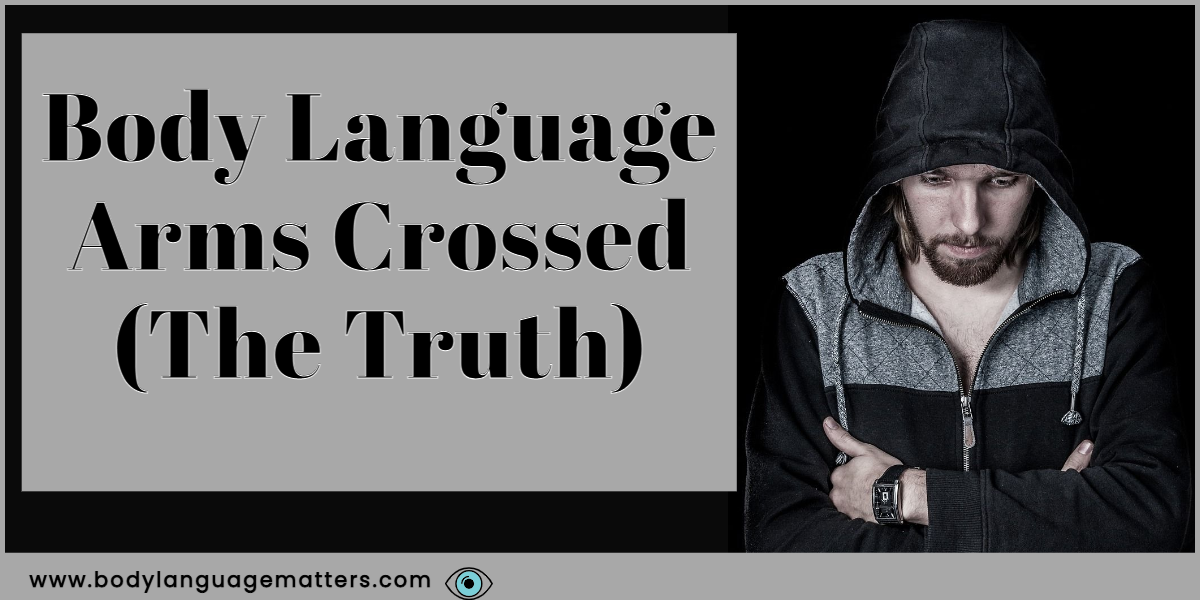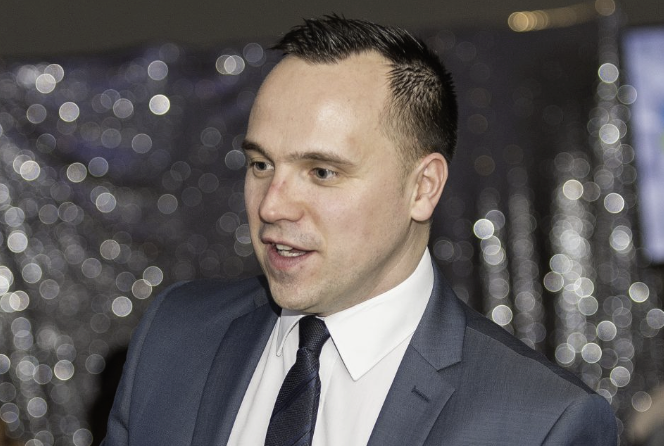Have you ever been told that crossing your arms is a negative gesture, or that it shows a feeling of defensiveness? In this post, we’ll get to the bottom of the meaning behind why people cross their arms and look at some of the body language myths surrounding this gesture.
The crossed arms position is often used as a way to protect oneself, either physically or emotionally. It can be seen as a defensive posture as if the person is trying to shield themselves from something. This body language cue can also indicate that the person is closed off or unapproachable but this all depends on the context and the grip.
We need to take into account other cues when trying to interpret what someone’s crossed arms might mean.
- The tighter the grip, the stronger the need for reassurance.
- Palms hugging the body this another sign of reassurance.
- Thumbs sticking out and upwards is a cue for confidence.
- Hand expanding is a sign of anger.
- The hand on the upper arms (biceps) is a sign of intimation.
Context is a major factor in understanding body language. A simple way to think about contact is to consider where the person is, what they are doing, and why they are there. This will give us clues as to how the person is feeling. (See more in the frequently asked question section below.)
“It’s important to remember that there are no absolute rules when it comes to nonverbal communication; one body language cue doesn’t necessarily mean this or that. For example, arms folded down don’t necessarily mean anything specific.”
Next up we will take a look at 11 different meanings as to why someone would be crossing their arms in the first place.
- 11 Meaning of Why The Arms Are Crossed.
- The person is closed off.
- The person is showing defensiveness.
- The person may be hiding something.
- It can show that the person is disinterested.
- It can be a sign of boredom.
- The person is closed off and not interested in what you have to say.
- The person is cold and wants to warm up.
- The person is thinking and processing information.
- The person is nervous or anxious.
- The person is resting or taking a break.
- Frequiently Asked Questions.
- How Do You Read Arms?
- What Is Context In Body Language?
- body language arms crossed over the chest.
- body language arms crossed overhead.
- body language arms crossed over the stomach.
- body language arms crossed over chest male.
- Are Crossed Arms Rude?
- Are crossed arms OK?
- Arms crossed with fists clenched what does it mean?
- Final Thoughts.
11 Meaning of Why The Arms Are Crossed.
- The person is closed off.
- The person is showing defensiveness.
- The person may be hiding something.
- It can show that the person is disinterested.
- It can be a sign of boredom.
- The person is closed off and not interested in what you have to say.
- The person is cold and wants to warm up.
- The person is thinking and processing information.
- The person is nervous or anxious.
- The person is resting or taking a break.
- It’s a person’s natural resting position.
All of the below answer will depend on the context body language experts agree this is the only way to read nonverble cues.
The person is closed off.
The person’s arms are crossed in front of them, and their body language indicates that they are closed off. This may be because they are feeling defensive or uncomfortable. They may also be trying to signal that they don’t want to engage in conversation.
The person is showing defensiveness.
The person’s arms are crossed in front of their body in a way that suggests they are feeling defensive. This body language is often used when someone feels threatened or is unwilling to engage with others. It can also be a sign that the person is feeling uncomfortable or is trying to protect themselves from being hurt.
The person may be hiding something.
The person may be hiding something if they have their arms crossed. This is a common body language cue that someone is feeling defensive or uncomfortable. If you notice someone exhibiting this behavior, it may be worth asking them what’s going on.
It can show that the person is disinterested.
When someone has their arms crossed in front of them, it can often be a sign that they are disinterested in what is happening around them. This body language cue can be interpreted in a number of ways, but typically it means that the person is not interested in engaging with others.
It can be a sign of boredom.
When a person’s arms are crossed in front of their body, it can be a sign that they are feeling bored or uninterested. This body language cue is often used in social settings, such as when someone is listening to a boring speaker or when they are surrounded by people they don’t know well. If you see someone with their arms crossed, it might be a good idea to try to engage them in conversation or offer them an activity to do.
The person is closed off and not interested in what you have to say.
The person’s arms are crossed in front of their body and they are not making eye contact with you. This suggests that they are not interested in what you have to say and are closed off to you.
The person is cold and wants to warm up.
The person is chilly and wants to warm up. They are crossing their arms in a way that suggests they are cold.
The person is thinking and processing information.
The person may be thinking and processing information if their arms are crossed. This body language suggests that the person is closed off and not interested in engaging with others.
The person is nervous or anxious.
The person is clearly nervous or anxious, their arms are crossed in front of them in a protective gesture. Their body language is telling us that they are not comfortable or confident in the situation they are in. This may be due to a number of factors, such as being in a new or unfamiliar environment or feeling threatened or outnumbered. Whatever the reason, it is important to respect their personal space and give them the time and space they need to feel more comfortable.
The person is resting or taking a break.
The person is resting or taking a break. Their arms are crossed in front of them, which is a common body language posture when someone is feeling relaxed.
Next up we will take a look at some commonly asked question.
Frequently Asked Questions.
How Do You Read Arms?
When you are trying to read someone’s arms, you are looking at their gesture and body language. If their arms are crossed, it might mean that they are feeling defensive. If their arms are open, it might mean that they are receptive. One gesture is not always indicative of a person’s feelings, so you need to look at the whole person to get a sense of how they are feeling.
What Is Context In Body Language?
Body language is a form of nonverbal communication in which physical behaviors, such as posture, gestures, and facial expressions, are used to convey messages. It can also be used to provide information about a person’s emotional state. For example, someone who is feeling angry may fold their arms or cross them in order to appear more closed off.
body language arms crossed over the chest.
The arms crossed over the chest is often used as a gesture of defensiveness or resistance. It can communicate feelings of anger, hostility, or disagreement.
body language arms crossed overhead.
The arms crossed over the head is a common body language gesture that can have a variety of meanings. In some cases, it may be used as a defensive posture or to signal that someone is not interested in what another person is saying. It can also be a way to self-comfort or self-soothe in times of stress. While the arms crossed over the head gesture can sometimes be interpreted negatively, it is important to remember that body language is often highly contextual and that this gesture can mean different things in different situations.
body language arms crossed over the stomach.
The position of the arms crossed over the stomach is often interpreted as a sign of defensiveness or guardedness.
body language arms crossed over chest male.
The crossed arms signal indicates that the person is not approachable and is not interested in talking. This is a way of protecting oneself and signaling that they are not open to others.
Are Crossed Arms Rude?
Crossed arms are often seen as a sign of rudeness, but this is not always the case. Sometimes people cross their arms in order to stay warm, or because they are simply more comfortable in that position. If someone has their arms crossed while talking to you, it is best to not assume that they are being rude and instead try to carry on a normal conversation.
Are crossed arms OK?
As a general rule, crossed arms are seen as negative body language. They can be interpreted as a sign of defensiveness, hostility, or disagreement. However, there are some situations where crossed arms may be seen as positive body language. For example, if someone is cold, they may cross their arms to stay warm. Or, if someone is holding a baby, they may need to use both hands and so will cross their arms. In these cases, crossed arms are not considered negative body language.
Arms crossed with fists clenched what does it mean?
The person’s body language indicates that they are angry and ready to fight. Their arms are crossed protectively in front of them, and their fists are clenched, showing that they are prepared to defend themselves. The hostility present in their posture and expression makes it clear that they are not open to communication or negotiation.off
Final Thoughts.
When it comes to arms crossed, there are plenty of meanings but the main takeaway is you can’t simply tell if someone is closed off just because their arms are folded. Context is important to understand what is really going on with that person. We hope you have found the answer to your questions and you may also find this post useful Body Language Arms Folded.

